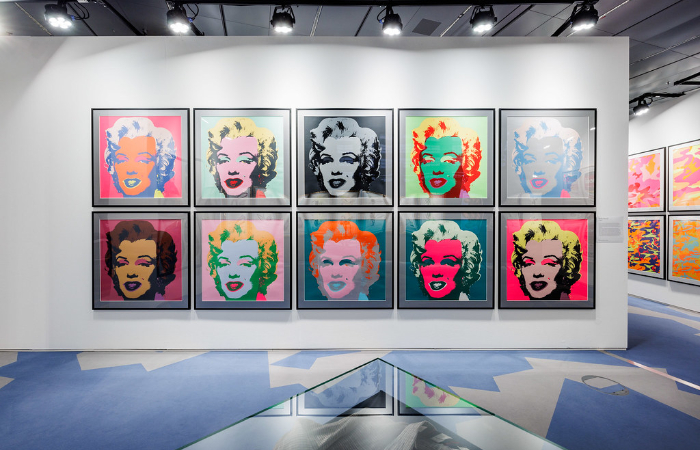Defining pop art: a cultural revolution
Pop Art emerged in the mid-1950s in Britain and later in the United States, challenging traditional notions of fine art by incorporating imagery from popular and mass culture. This movement blurred the lines between «high» art and «low» culture, embracing elements like advertising, comic books, and mundane mass-produced objects. By doing so, Pop Art reflected and critiqued the burgeoning consumerism and media saturation of the post-war era.
The term «Pop Art» was first coined by British curator Lawrence Alloway in 1955 to describe a new form of art that drew inspiration from the imagery of consumerism, new media, and mass reproduction. Artists like Richard Hamilton and Eduardo Paolozzi in Britain, and Andy Warhol and Roy Lichtenstein in the U.S., became prominent figures in this movement, each bringing their unique perspective to the exploration of popular culture.
The roots: Britain’s Independent Group
In 1952, the Independent Group (IG) formed in London, comprising artists, writers, and critics who sought to challenge prevailing modernist approaches to culture and art. They engaged in discussions about mass advertising, movies, product design, comic strips, science fiction, and technology. A pivotal moment was the 1956 exhibition «This Is Tomorrow» at the Whitechapel Gallery, which showcased the integration of art and modern life.
Richard Hamilton’s collage, Just what is it that makes today’s homes so different, so appealing?, is often cited as one of the earliest examples of Pop Art. It juxtaposed images from American magazines, reflecting the influence of consumer culture on British society.
American pop art: a reaction to abstraction
In the United States, Pop Art emerged as a reaction against the dominant artistic movement of the time, Abstract Expressionism. Artists like Jasper Johns and Robert Rauschenberg began incorporating everyday objects and imagery into their work, challenging the idea that art should be an expression of the artist’s inner emotions.
Andy Warhol, perhaps the most iconic figure of American Pop Art, utilized techniques like silkscreen printing to mass-produce images of celebrities and consumer goods, such as his famous Campbell’s Soup Cans. Roy Lichtenstein drew inspiration from comic strips, creating large-scale paintings that mimicked the printing techniques of mass media.
Key characteristics of pop art
- Incorporation of popular culture: Pop Art drew heavily from advertising, comic books, and everyday consumer goods, reflecting the pervasive influence of mass media.
- Bold imagery and colors: Artists employed bright, vibrant colors and clear lines to mimic the aesthetic of commercial art.
- Use of mechanical reproduction: Techniques like silkscreen printing allowed for the mass production of artworks, challenging the notion of art as a unique, handcrafted object.
- Irony and parody: Pop Art often employed humor and satire to critique consumerism and the commodification of culture.
Influences shaping the movement
Consumer culture and mass media
The post-war economic boom led to a surge in consumer goods and advertising, which became central themes in Pop Art. Artists reflected on and critiqued the growing materialism and the omnipresence of media in everyday life.
Dadaism and Surrealism
Pop Art was influenced by earlier movements like Dadaism, which embraced absurdity and challenged traditional art forms, and Surrealism, which explored the unconscious mind. These movements paved the way for Pop Art’s embrace of unconventional subjects and techniques.
Technological advancements
The rise of television, photography, and printing technologies provided new tools and subjects for artists. The ability to reproduce images mechanically allowed Pop Artists to comment on the proliferation of media and its impact on society.
Youth culture and rebellion
The 1950s and 1960s saw the emergence of a distinct youth culture that rejected traditional norms. Pop Art resonated with this demographic by embracing popular music, fashion, and icons, positioning itself as a rebellious alternative to established art forms.
Global impact and legacy
Pop Art’s influence extended beyond Britain and the U.S., inspiring artists worldwide. In Spain, artists like Eduardo Arroyo and Equipo Crónica incorporated Pop Art elements to comment on political and social issues. In Japan, artists such as Yayoi Kusama and Tadanori Yokoo blended Pop Art with traditional Japanese aesthetics, creating unique interpretations of the movement.
Today, Pop Art continues to influence contemporary artists and designers, evident in the ongoing fascination with celebrity culture, branding, and the intersection of art and commerce. Its legacy is a testament to its ability to capture and critique the zeitgeist of the modern era.
